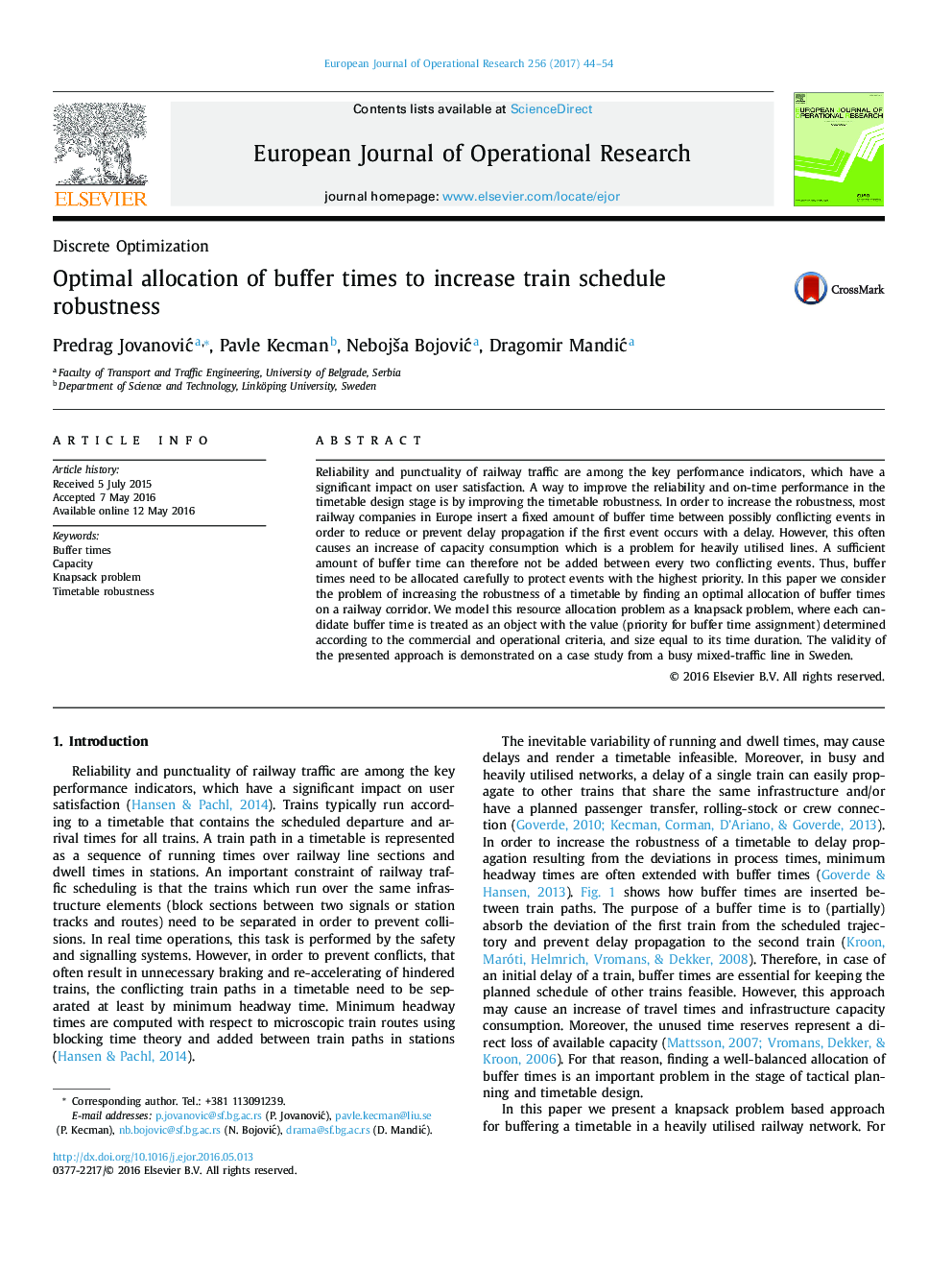| کد مقاله | کد نشریه | سال انتشار | مقاله انگلیسی | نسخه تمام متن |
|---|---|---|---|---|
| 4960086 | 1445969 | 2017 | 11 صفحه PDF | دانلود رایگان |
عنوان انگلیسی مقاله ISI
Optimal allocation of buffer times to increase train schedule robustness
ترجمه فارسی عنوان
تخصیص بهینه زمان بار بافر برای افزایش استحکام برنامه قطار
دانلود مقاله + سفارش ترجمه
دانلود مقاله ISI انگلیسی
رایگان برای ایرانیان
کلمات کلیدی
زمان بافر، ظرفیت، مشکل حلقه ثبات جدول زمانی،
ترجمه چکیده
قابلیت اطمینان و موقت بودن ترافیک راه آهن از جمله شاخص های عملکرد کلیدی است که تأثیر قابل توجهی بر رضایت کاربر دارد. یک راه برای بهبود قابلیت اطمینان و عملکرد به موقع در مرحله طراحی زمانبندی، بهبود استحکام زمانبندی است. به منظور افزایش قابلیت اطمینان، اکثر شرکت های راه آهن در اروپا یک مقدار ثابت از زمان بافر بین وقایع احتمالا متضاد را وارد می کنند تا در صورت وقوع رویداد اول با تاخیر، کاهش یا جلوگیری از انتشار تاخیر ایجاد شود. با این حال، این اغلب موجب افزایش مصرف مصرفی می شود که برای خطوط به شدت مورد استفاده قرار می گیرد. بنابراین مقدار کافی از زمان بافر در هر دو وقفه متضاد نمی تواند اضافه شود. بنابراین، زمان های بافر باید با دقت اختصاص داده شود تا از وقایع با بالاترین اولویت محافظت کند. در این مقاله، مسئله افزایش استحکام یک جدول زمانی را با یافتن یک تخصیص بهینه از زمان بافر در یک راهرو راه آهن در نظر می گیریم. ما این مسئله تخصیص منابع را به عنوان یک مشکل حلقه ای مدل سازی می کنیم که هر زمان بافر کننده نامزد به عنوان یک جسم با ارزش (اولویت برای تعیین زمان بافر) مطابق با معیارهای تجاری و عملیاتی و اندازه برابر با مدت زمان آن رفتار می شود. اعتبار رویکرد ارائه شده در یک مطالعه موردی از یک خط ترافیکی مشغول به کار در سوئد نشان داده شده است.
موضوعات مرتبط
مهندسی و علوم پایه
مهندسی کامپیوتر
علوم کامپیوتر (عمومی)
چکیده انگلیسی
Reliability and punctuality of railway traffic are among the key performance indicators, which have a significant impact on user satisfaction. A way to improve the reliability and on-time performance in the timetable design stage is by improving the timetable robustness. In order to increase the robustness, most railway companies in Europe insert a fixed amount of buffer time between possibly conflicting events in order to reduce or prevent delay propagation if the first event occurs with a delay. However, this often causes an increase of capacity consumption which is a problem for heavily utilised lines. A sufficient amount of buffer time can therefore not be added between every two conflicting events. Thus, buffer times need to be allocated carefully to protect events with the highest priority. In this paper we consider the problem of increasing the robustness of a timetable by finding an optimal allocation of buffer times on a railway corridor. We model this resource allocation problem as a knapsack problem, where each candidate buffer time is treated as an object with the value (priority for buffer time assignment) determined according to the commercial and operational criteria, and size equal to its time duration. The validity of the presented approach is demonstrated on a case study from a busy mixed-traffic line in Sweden.
ناشر
Database: Elsevier - ScienceDirect (ساینس دایرکت)
Journal: European Journal of Operational Research - Volume 256, Issue 1, 1 January 2017, Pages 44-54
Journal: European Journal of Operational Research - Volume 256, Issue 1, 1 January 2017, Pages 44-54
نویسندگان
Predrag JovanoviÄ, Pavle Kecman, NebojÅ¡a BojoviÄ, Dragomir MandiÄ,
